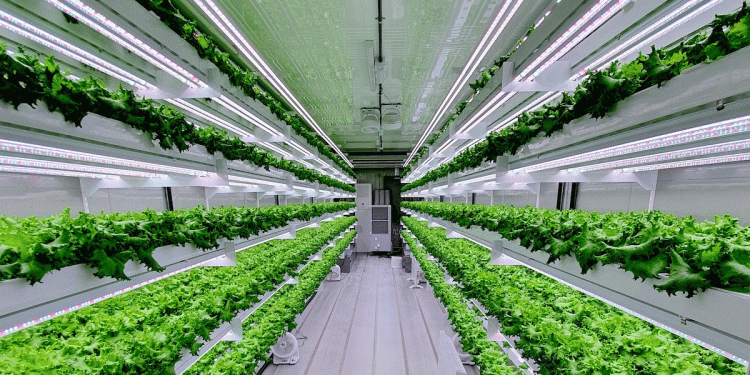As climate change exacerbates extreme weather conditions, traditional farming faces increasing obstacles in crop reliability and sustainability. This is especially true for regions where frequent droughts, floods, and soil degradation reduce productivity. Vertical farming has rapidly developed as a high-tech solution to these issues, providing a stable, efficient agricultural method largely insulated from adverse weather. Recent examples in Lithuania and Spain illustrate the potential of vertical farms, showing how they meet food demands while conserving resources and delivering consistent, high-quality yields.
A High-Tech Farming Solution for a Climate-Stressed World
The vertical farm located in Vilnius, Lithuania, represents one of Europe’s largest and most advanced vertical farms. With layered hydroponic beds that stand 9 meters high, this facility grows leafy greens like lettuce and aromatic herbs in a fully controlled environment. Hydroponic farming, which involves suspending plants in nutrient-rich water, enables crops to grow without soil. This method allows for 90% less water usage compared to traditional agriculture, a feature that is crucial in areas facing water scarcity. Joaquin Bas, co-founder of a similar operation in Spain, emphasizes the importance of water recirculation, stating that their process conserves water effectively and offers substantial environmental advantages.
The ability of vertical farms to control growth conditions—such as temperature, humidity, and lighting—ensures year-round crop production without the unpredictability of climate and pest pressures. As a result, these farms can consistently meet market demand, producing steady, high-quality yields. In contrast to traditional outdoor farming, where yields can vary greatly due to changing environmental factors, vertical farms offer reliability and consistent supply, giving them a competitive advantage.
Economic and Market Impact of Vertical Farming
Since 2022, the Lithuanian farm has been supplying local markets with fresh produce free from pesticides and herbicides. Although initial challenges included market awareness and retail partnerships, the farm now has 35 employees and a 7,000-square-meter facility, which is set to double by 2025. In Spain, Bas’s vertical farm employs 40 people and has over 3,000 square meters of production space. These farms have positioned themselves as key suppliers of crops that are hard to grow outdoors or are in high demand, such as certain leafy greens and herbs, filling a niche that traditional farms cannot meet.
The scalability of vertical farms makes them especially appealing for urban centers and regions with limited arable land. Bas notes that while eco-farming generally incurs high costs, the efficiency of vertical farms, producing 40 times more per square meter than traditional fields, has enabled them to compete in price with conventional produce in supermarkets. The productivity and efficiency gains underscore the business viability of vertical farming, which in turn secures jobs, supports local economies, and creates a model for sustainable food systems.
Technological and Financial Challenges
Despite their benefits, vertical farms also face hurdles. Initial investments are high, covering land, facility construction, and technology. In the U.S., many vertical farms have shuttered due to an unsustainable financial model, largely due to inadequate planning around the specific crops most suitable for vertical farming. Vertical farms must carefully choose crops that suit both the growing environment and market demands, as explained by Bas, whose Spanish farm emphasizes unique crops that conventional farms in the region cannot supply.
For long-term success, vertical farms need continuous technological innovation. Bas’s farm has prioritized advancements in production and efficiency to remain competitive. Vertical farms will continue to scale globally if they address such obstacles and adapt to local agricultural and market needs.
Vertical farming offers a promising solution for sustainable agriculture in a climate-challenged world. By reducing water use, eliminating pesticide reliance, and offering stable, high-yield production, vertical farms provide a resilient option for crop production. Although initial setup costs and technical demands are significant, successful models in Lithuania and Spain illustrate how vertical farms can create sustainable, reliable food sources. As global food needs grow and environmental challenges intensify, vertical farming stands poised to redefine how and where we grow our food, supporting both local markets and environmental conservation.













